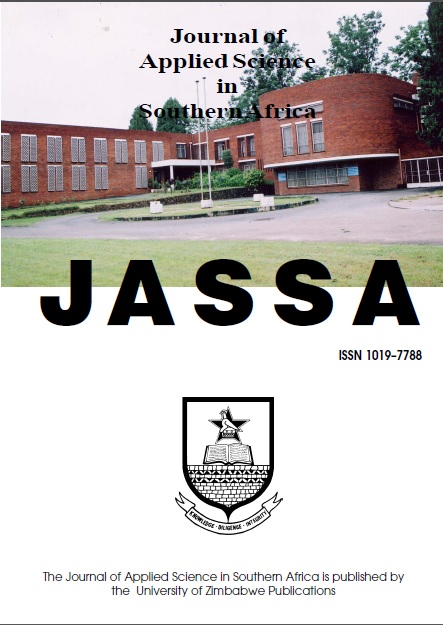
JOURNAL OF APPLIED SCIENCE IN SOUTHERN AFRICA
University of Zimbabwe Publications
DOI: 10.5897/UJ-JASSA
Email: uzpub@admin.uz.ac.zw
Antibacterial, Antifungal and Anti-inflammatory properties of the wild and domesticated Sorghum cereal plants of Zimbabwe
DOI: 10.5897/UJ-JASSA.17.006.2 | Article Number: CF6C66B06 | Vol.22 (2) - December 2016
Authors: Taderera T. , Chitindingu K. , Marume A. and Muchuweti M.
Keywords: Antibacterial; Antifungal; Anti-inflammatory; Cyclo- oxyginase, Candida albicans, Staphylococcus aureus
Water, methanol (MetOH) and ethanol (EtOH) extracts obtained from seeds and roots of the red variety of Sorghum bicolor (domesticated) and Sorghum arundinaceum (wild plant) were assayed for antibacterial, antifungal and anti-inflammatory (COX- 1 and COX-2) activities. The antibacterial and antifungal activities were evaluated using micro-dilution assays against a Gram- positive (Staphylococcus aureus), Gram-negative bacteria (Escherichia coli) and the fungus Candida albicans. Both MetOH and EtOH extracts of Sorghum bicolor and Sorghum arundinaceum (roots and seeds) were found to inhibit bacterial and fungal growth. Water extracts generally exhibited low inhibition capacity. EtOH extracts for Sorghum bicolor and Sorghum arundinaceum roots had the inhibitory capacity with Minimum inhibitory concentration (MIC) values (0.195 and 0.45 mg/mL respectively). The EtOH extracts of roots also had the highest inhibition capacity for both Sorghum bicolor (with minimum fungicidal concentration (MFC) of 0.74 mg/mL) and Sorghum arundinaceum (with MFC value of 0.64 mg/mL). Both plant extracts were found to exhibit significant anti-inflammatory activity. All the extracts from the different solvents inhibited cyclo- oxygenase activity. As a preliminary indicator of antibacterial, antifungal as well as anti-inflamatory activity, alcoholic extract results for both plants are significant and can be the starting point for the search for new drug sources.
BENSON, K.F; BEAMAN, J.L; OU, B; OKUBENA, A.; OKUBENA, O AND GITTE, S. (2013). West African Sorghum bicolor Leaf Sheaths Have Anti-Inflammatory and Immune- Modulating Properties In Vitro. Journal of Medicinal Food. 16(3): 230–238.
DA SILVA, B.P., SILVA, G,M., MENDES, T.P. AND PARENTE. J.P. (2003). Structural Characteristics of a Bioactive Polysaccharide from Sorghum arundinaceum. Z. Naturforsch. 58c, 342-346.
DOGGETT H., (1988). Sorghum, John Wiley & Sons, New York, NY, USA; Longman Scientific & Technical, Harlow, UK.
DUODU K. G., TAYLOR J. R. N., BELTON, P. S. AND HAMAKER B. R. (2003). “Factors affecting sorghum protein digestibility,” Journal of Cereal Science, vol. 38, no. 2, pp. 117 131.
ELDEEN, I.M.S., VAN STADEN, J., (2008). Cyclooxygenase inhibition and antimycobacterial effects of extracts from Sudanese medicinal plants. South African Journal of Botany 74, 224-229.
ELOFF, J.N., (1998b). Which extractant should be used for the screening and isolation of antimicrobial components from plants? Journal of Ethnopharmacology 60, 1–8. ELOFF, J.N., (1998). A sensitive and quick microplate method to determine the minimal inhibitory concentration of plant extracts for bacteria. Planta Medica 64, 711-713.
ELOFF, J.N., (1999). The antibacterial activity of 27 Southern African members of the Combretaceae. South African Journal of Science, 95:148-152.
ELOFF, J.N., (2004). Quantifying the bioactivity of plant extracts during screening and bioassay-guided fractionation. Phytomedicine. 11:370-371.
ELOFF, J.N., PICARD J. AND MASOKO, P., (2007). Resistance of animal fungal pathogens to solvents used in bioassays. South African Journal of Botany, 73: 667-669.
INTERNATIONAL CROPS RESEARCH INSTITUTE OF THE SEMI-ARID TROPICS (1996). The World Sorghum and Millet Economies Facts, Trends and Outlook, ICRISAT/FAO, Rome, Italy.
KIM, J.H., RHEE, H.I., JUNG, I.H., RYU, K.H., JUNG, K., HAN, C.K., KWAK, W.J., CHO, Y.B., JOO, H.J., (2005). SKI306X, an oriental herbal mixture, suppresses gastric leukotriene B4 synthesis without causing mucosal injury and the diclofenac- induced gastric lesions. Life Sciences 77, 1181–1193.
KLEIH, U; BALA R. S. AND DAYAKAR R. B. (2000). Industrial utilization of sorghum in India. Working Paper Series no. 4, Socioeconomics and Policy Program. Patancheru 502 324, Andhra Pradesh, India: International Crops Research Institute for the Semi-Arid Tropics. 38 pp.
KLOPFENSTEIN C. F. AND HOSENEY R. C., (1995). “Nutritional properties of sorghum and the millets,” in Sorghum and Millets Chemistry and Technology, D. A. V. Dendy, Ed., pp. 125–168, American Association of Cereal Chemists, St. Paul, Minn, USA.
LUSEBA, D., ELGORASHI, E.E., NTLOEDIBE, D.T., VAN STADEN, J., (2007). Antibacterial, anti-inflammatory and mutagenic effects of some medicinal plants used in South Africa for treatment of wounds and retained placenta in livestock. South African Journal of Botany 73, 378–383.
MOHAMMED, S., AZUBUIKE, C, P., ODULAJA, J, O., AND SOWEMIMO, A. (2013). Studies on the Extract of the Straw of Sorghum arundinaceum and Its Formulation as an Oral Solid Dosage Form. Journal of Pharmacy. pg 2319-4219.
MASOKO, P., PICARD, J., ELOFF, J.N., (2007). The antifungal activity of twenty-four southern Africa Combretum species (Combretaceae). South African Journal of Botany 73, 173-183.
MORTON, J.F (1981). Atlas of Medicinal Plants of middle America. Bahamas to Yucatan. C.C. Thomas, Springfield, II.
OLEMBO, N.K., FEDHA, S.S., NGAIRA, E.S., (1995). Medicinal and Agricultural plants of Ikolomani Division, Kakamega District. Signal press L.t.d Nairobi.
POLY, A, G., (2003). Biochemical Targets of Plant Bioactive Compounds: A pharmacological reference guide to sites of action and biological effects. CRC Press, London
RABE, T., VAN STADEN, J., (1997). Antibacterial activity of South African plants used for medicinal purposes. Journal of Ethnopharmacology 56, 81–87.
SHANTHARAM, S., (1995). “The importance of biosafety in the deployment of private transgenic sorghums in the environment,” African Crop Science Journal, vol. 3, no. 2, pp. 131–133.
TAYLOR, J.L.S., VAN STADEN, J., (2001). COX-1 inhibitory activity in extracts from Eucomis L’Herit. species. Journal of Ethnopharmacology 75, 257–265.
